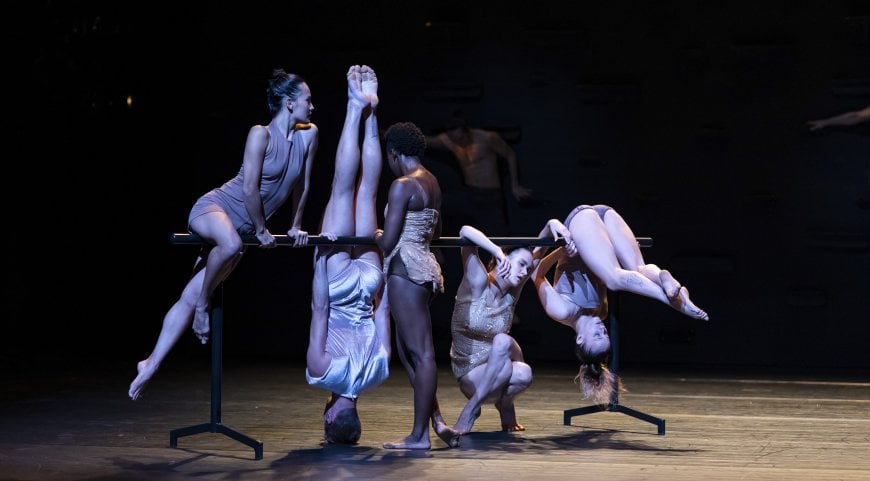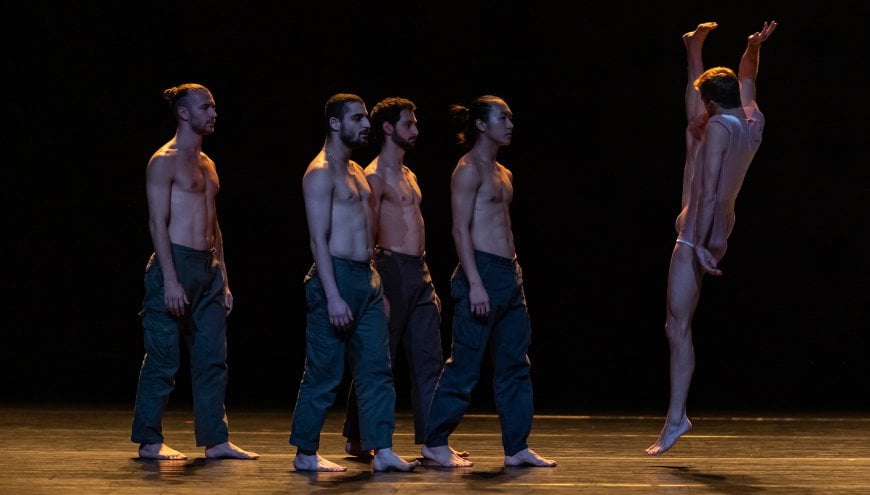Review:
Batsheva Dance Company
UCSB Arts & Lectures presents Momo and the politics of dancing.
WORDS Ninette Paloma
The evening begins in Butoh: silent, meditative, and starkly cohesive. Four bare-chested men in matching cargo pants move rhythmically to the sound of their collective breath as the audience settles into their seats. When the gasp of strings and percussion begins to fill the stage, a dancer in velvet capped sleeves enters, thrusting his hips skyward in desperate opposition. One, two, six more disruptors join his charge, writhing against the tide with piercing ferocity as the four men continue, unfussed. The haunting soundscape of Laurie Anderson and Kronos Quartet quivers around a tale of two realities, where consensus and dissidence brush shoulders, never to meet in the center, existing only in parallel.
The artist Ai Weiwei once famously observed that everything is art and everything is political, and in the case of Israel’s acclaimed Batsheva Dance Company: yes. Just last year, the Israeli Minister of Culture & Sports called for a reevaluation of the company’s state funding after the Palestinian flag was included in one of its staged works. And there are few international touring companies that claim to draw an equally passionate crowd both inside and outside of the theatre (the protesters who showed up to Tuesday’s performance held a captive audience as patrons slowly passed through a screening process before entering).
The truth is that a healthy portion of Ohad Naharin’s tenure as Artistic Director (and now Resident Choreographer) has been spent shaking off assumptions that the company is a government propaganda tool or not nationalistic enough; too political or not progressive enough. Never mind the fact that more than half of the company dancers hail from other countries or that Momo itself was produced in 2022, born out of the pandemic and in co-creation with the dancers themselves. During times of suppression and upheaval, art is an effective lightning rod – and Naharin is no stranger to battling it out on the dance floor.
Using the abstract language of Gaga, Momo considers broad themes of conformity and conflict while instantly provoking subjectivity: Do you empathize with the insulated, cooperative, ass-kissing (literally) quartet or the radical vulnerability of seven autonomous dancers? Using ballet as symbolism, Momo turns tradition on its head with an unorthodox barre section led by the striking Londiwe Khoza only to crucify that same innovation (with the barre standing in for a cross) in the next breath. For seventy captivating minutes, repetition becomes a metaphor for solidarity, and freedom is represented through a dramatic and expansive climbing wall. In search, perhaps, for safety or a new perspective, each group takes turns ascending higher and toward the unclaimed – the quartet with frightening indifference, the soloists steeped in desperation. Try as they may, neither group comes out on top, doomed instead to circle one another in numbing isolation. With raw sensitivity and unwavering honesty, Momo accomplishes the seemingly impossible: compassion and a voice for all.
The artist Ai Weiwei once famously observed that everything is art and everything is political, and in the case of Israel’s acclaimed Batsheva Dance Company: yes. Just last year, the Israeli Minister of Culture & Sports called for a reevaluation of the company’s state funding after the Palestinian flag was included in one of its staged works. And there are few international touring companies that claim to draw an equally passionate crowd both inside and outside of the theatre (the protesters who showed up to Tuesday’s performance held a captive audience as patrons slowly passed through a screening process before entering).
The truth is that a healthy portion of Ohad Naharin’s tenure as Artistic Director (and now Resident Choreographer) has been spent shaking off assumptions that the company is a government propaganda tool or not nationalistic enough; too political or not progressive enough. Never mind the fact that more than half of the company dancers hail from other countries or that Momo itself was produced in 2022, born out of the pandemic and in co-creation with the dancers themselves. During times of suppression and upheaval, art is an effective lightning rod – and Naharin is no stranger to battling it out on the dance floor.
Using the abstract language of Gaga, Momo considers broad themes of conformity and conflict while instantly provoking subjectivity: Do you empathize with the insulated, cooperative, ass-kissing (literally) quartet or the radical vulnerability of seven autonomous dancers? Using ballet as symbolism, Momo turns tradition on its head with an unorthodox barre section led by the striking Londiwe Khoza only to crucify that same innovation (with the barre standing in for a cross) in the next breath. For seventy captivating minutes, repetition becomes a metaphor for solidarity, and freedom is represented through a dramatic and expansive climbing wall. In search, perhaps, for safety or a new perspective, each group takes turns ascending higher and toward the unclaimed – the quartet with frightening indifference, the soloists steeped in desperation. Try as they may, neither group comes out on top, doomed instead to circle one another in numbing isolation. With raw sensitivity and unwavering honesty, Momo accomplishes the seemingly impossible: compassion and a voice for all.

